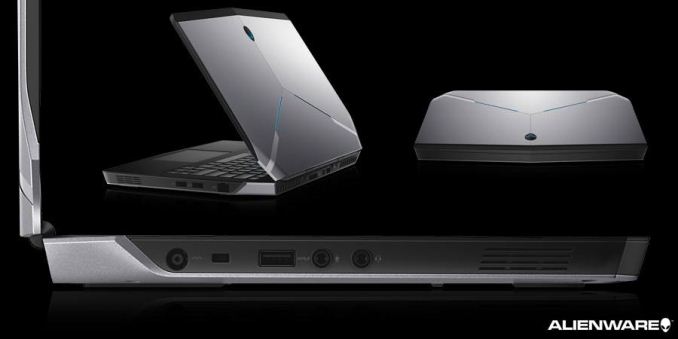Alienware Launches The Alienware 13 Gaming Laptop With A Twist
by Brett Howse on October 28, 2014 7:00 AM EST- Posted in
- Systems
- Alienware
- Laptops
- Alienware 13

Alienware teased the new, smaller version of their gaming laptop in August. Available today, the Alienware 13 is the 4.5 pound little brother to the Alienware 14, but this gaming laptop has a twist. Alienware is offering an add-on Alienware Graphics Amplifier, which lets you plug a desktop GPU into this portable machine to dramatically increase performance.
Let us take a quick look at the new Alienware 13 though. While not as small as an ultrabook, it is significantly thinner than the 14 inch model, coming in at just under 1 inch thick. This, coupled with the two pounds less weight than the larger model, should make it a lot more portable.
The CPU will be Intel i5 and i7 Haswell U series parts, and the GPU offerings will be up to the NVIDIA GTX 860M. This will power a display, which at the default configuration is a lowly 1366x768 IPS panel, but luckily the display can be upgraded significantly with 1920x1080, and 2560x1440 options, as well as optional touch.
The base $999 model also comes with a 5400 rpm 1 TB hard drive as the base option, however the laptop can be outfitted with SSDs as well. In late 2014, it seems hard to believe that a $999 computer can still come with a slow mechanical hard drive, so hopefully the upgrade to SSD storage does not break the bank.
The star or the show though is the Alienware Graphics Amplifier, which is a first for this segment. Ryan will be covering this in full, but this $300 add-on is certainly a unique offering from Dell. With a dedicated 460 watt power supply just for the GPU, the amplifier should help the Alienware 13 with thermals when gaming on the discrete GPU. However, you can fall back to the GPU built into the laptop when you are on the go. Hopefully this adapter gets added to the entire Dell laptop line.
Unfortunately, details are light on this launch, with Alienware not releasing any press releases at the time of this writing. Check in to www.alienware.com starting today to check out all of the available pricing and options for the Alienware 13.












21 Comments
View All Comments
DanNeely - Tuesday, October 28, 2014 - link
PCIe 2.0 4x is equivalent to the 3.0 x2 in the article I linked; which is narrow enough to start hurting some games badly.TB2's 20gbps bandwidth is equivalent to 2.5 PCIe 3.0 lanes which is what I was referring to.
repoman27 - Tuesday, October 28, 2014 - link
The back end is still PCIe 2.0 x4 though, so that's all she wrote. The Alienware Graphics Amplifier is apparently PCIe 2.0 x4 + USB 3.0, so not hugely different in terms of peak GPU performance.flemeister - Tuesday, October 28, 2014 - link
The 1366x768 panel is TN, not IPS. =(olafgarten - Tuesday, October 28, 2014 - link
Didn't MSI do something similar recently?olafgarten - Tuesday, October 28, 2014 - link
Here it is http://www.pcworld.com/article/2605879/this-msi-la...I guess the alienware solution is more versatile because it connects through a cable, but it's a similar concept.
DanNeely - Tuesday, October 28, 2014 - link
About a decade ago one the docks available for Dell's Latitude C series had room for an expansion card; don't recall if it was PCI or AGP though, It was a much more compact dock than MSI's monolith; but it only needed to handle single slot cards that were powered via the bus alone.BrokenCrayons - Tuesday, November 4, 2014 - link
The D-series Dell also supported an expansion card with one of their two docking devices. It was a PCI slot and since the power supply in the dock was only 135 watts and the enclosure was a confined area with active cooling (though limited to one 60mm fan) it wasn't a good gaming solution, though you could squeeze a little more performance from a D series laptop (that's early Core Duo and Core2 Duo stuff) with Intel graphics if you went through the trouble. It was not at all an elegant solution though and for people who like to play games in their lap, getting an upgraded GPU was probably a better option, though the D630 and D830 had faulty 8000 series nvidia cards with high failure rates. :(barleyguy - Tuesday, October 28, 2014 - link
I'm curious how easy it is to swap the hard drive, and whether it's a standard 2.5".My current gaming laptop (a 14" Asus from a couple years ago) has a 512 GB SSD that I installed. I was thinking I could upgrade to this, and just move my SSD (and move the hard drive the other direction).
secretmanofagent - Tuesday, October 28, 2014 - link
How is the external GPU a different implementation than what Sony did three years ago with the Vaio Z? Is it using the Thunderbolt (a.k.a. Light Peak) port as well?http://www.anandtech.com/show/4474/sony-updates-va...
OrphanageExplosion - Thursday, October 30, 2014 - link
Interesting idea, but I suspect that you're going to be bottlenecked by the ultrabook CPU on a great many games. If you have a ton of cash to spare on an expansion chassis like this, the chances are you'll be housing a meaty GPU in it - one that's much more powerful than the GTX 860M (aka GTX 750 Ti) found in the laptop itself.I suspect that this will make a lot more sense when you can utilise it with a proper quad i7 in a larger Alienware laptop.